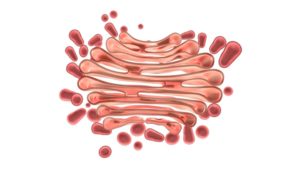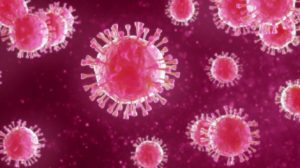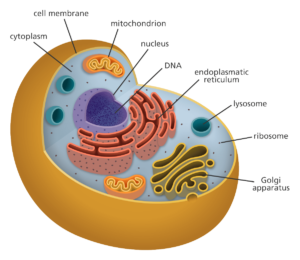The Corporeal Corporation
A cell is like a tiny, bustling office. Of course, this business exists not just for itself, but ultimately for the parent company, the human body, of which every cell is a part. How wonderful to think that you are a corporation formed by trillions of little enterprises!
Each of these miniscule businesses hums along with activities that resemble those in your workplace, but on a tinier scale.
- Just like at your job, the cell’s workday starts with a shot of caffeine – energy molecules in the form of ATP, produced by the mitochondria in the break room. The mitochondria also power the office equipment and keep the lights on.
- The Golgi apparatus houses the shipping department, boxing up outgoing cellular products and slapping on labels for delivery.

- Microtubules act as couriers within the office.
- Endosomes sort through incoming mail, then the lysosomes take out the trash and recycling.
- Cytotoxic granules operate the security system, neutralizing would-be prowlers.
Headquarters
Speaking of security, each cell is housed within a protected building, known as the cell membrane, a double-layered barrier of molecules that line up back to back with one another. This breathtaking structure is so well designed that if the dissociated molecules are placed by themselves in water, they will organize spontaneously into a structure. Picture Lego blocks so masterfully constructed that if they are shaken up in a bag, they automatically fit together into a fully formed toy!

Penetrating a cell’s membrane are complex protein structures that act like locked entrances. Only particular shapes can activate the locks in these specialized portals. Through these doorways authorized molecules gain access or egress, like vendors swiping ID badges as they make deliveries or collect outgoing mail. The card readers in the cell membrane are known as receptors.
Industrial Espionage
SARS-CoV-2, the cause of COVID-19, gains access to human cells with a fake ID badge, which in this case unlocks the ACE2 receptor on the cell surface. The ID itself is a viral structure called the spike protein. Spike proteins are the projections that jut from the virus like the points sticking off of a crown. These give the virus its name, corona, which means “crown.”

Since this spike protein is such a critical component in the disease process of COVID-19, it stands to reason that deactivating this phony badge has been the focus of preventing infections.
Growing Armamentarium
That is where vaccines come into play. As I have related in previous posts, vaccines harness the immense power of our natural immune systems, helping our bodies prepare beforehand for the onslaught of an infectious disease.
Many successful vaccines take just a fragment, a protein, from a germ, and introduce it into the body (by injection or ingestion). The intelligence officers of the immune system recognize this protein as foreign, and then design a system of smart weapons specially targeting it. If a real infection occurs later, the immune system is already trained and ready to destroy anything flying the enemy flag.
Several COVID vaccines, including the newest, the Novovax, utilize a subunit (a piece) of the spike protein of coronavirus. These are traditional sorts of vaccines, and they have proven effective at preventing COVID-19.
What is different about the newer technology of mRNA vaccines, like the Pfizer and the Moderna vaccines, that have caused such a stir and such optimism? To understand these vaccines, let’s go back to the microscopic office of the cell.
Upper Level Management
Like any healthy business, every cell has executive leadership. The nucleus, a walled off area in the middle of the cell is where management has its office. Precious business plans and trade secrets are locked in the vault there and periodically reproduced in the copy room of the nucleus and disseminated to new franchises as they are opened up through cellular reproduction.
But to be effective, plans must take shape. And take shape is literally what the information passed down from upper management does. In the nucleus, sections of the company manual, which is written in DNA code, are transcribed onto messenger RNA molecules. It is like encoded information saved in a readable format on a flash drive and transported out of the nucleus to the printer rooms.

Outside the nucleus, but still within the cell, lie the ribosomes, tiny 3-D printers, awaiting information on the flash drives. Reading the instructions written in the mRNA file, ribosomes synthesize (one peptide at a time) the 3-D shapes of proteins needed by the cell and the body as a whole.
It is noteworthy that the flash drives themselves, the mRNA molecules, do not last very long. Like something out of Mission Impossible, the files and the information they contain self-destruct after being run through the 3-D printers of the ribosomes.
Volunteer Army
Imagine that you are training soldiers at the frontlines to recognize the enemy. You could parade around before your troops with the wing of a downed hostile plane with the insignia still on it. That would teach rookie gunnery officers what to shoot at, but that form of training might be expensive and time-consuming.
It might be easier, if you had some stolen blueprints for the enemy plane, simply to email those to units all throughout the war front. There combat engineers could use these stolen files to recreate replicas of the wing for target practice using 3-D printers. That would be easier to disseminate to the fighters in the trenches for their war games. The obvious question is – where to find a supply of 3-D printers?
At our macroscopic level, the military could request volunteer civilian resources for the wartime effort, and the tremendous capacity of civilian 3-D printers in our country could easily generate the material for widespread training exercises.
At the microscopic level, the newer vaccines take advantage of the countless ribosomes, our own cellular 3-D printers that read mRNA files for printing. Since we actually do have a copy of stolen blueprints for coronavirus (we have sequenced the RNA in its genome), we simply inject into a patient a copy of man-made mRNA with part of the file that encodes the virus’ spike protein. Since that file contains readable plans for the viral protein, the ribosomes churn out 3-D printed copies of part of the viral spike protein.

Whether a traditional protein vaccine or a novel mRNA vaccine is given, the final effect is the same: a critical viral protein is released into the human body, and that induces an immune response that can prevent the real virus from infecting the host later. The only difference is how that protein got into the body.
In the traditional vaccine model, the viral protein is injected directly into the body. With the mRNA platform, only the information encoding the viral protein is injected. The body itself then mass produces the actual protein, which in turn trains the immune system to remember and await a confrontation with coronavirus.
It is important to note that the part of the spike protein that is synthesized by your own cellular 3-D printers is not a whole virus – not by a long shot. The product rolling out of the ribosomes forms enough of a fragment of the spike protein to trigger the immune response to prevent COVID infections. However, that bit of the spike protein can no more infect you or me than a section of an aircraft wing could fly by itself and drop bombs on us. It does not form an intact plane or weapon. Furthermore, the mRNA goes up in smoke after being read; it rapidly degrades.
If the effect is the same regardless of vaccine technology, what is all the fuss over? How is this mRNA technology an advantage over a protein vaccine? Proteins are extremely complex structures that are difficult and expensive to manufacture. But messenger RNA is easier, faster, and cheaper to mass produce.
More importantly, RNA is much more versatile. When the virus mutates, (analogous to newer models of enemy aircraft being developed) we don’t have to start from scratch making new proteins (which is time consuming and expensive). We just have to tweak the code in the mRNA of our vaccine, slightly altering the files we are feeding to the marvelous 3-D protein printers that already exist in our cells. It is much easier to stay ahead of mutations or even respond to new types of viruses with the flexibility of an mRNA platform of vaccines.
That is all well and good. But practical questions arise:
- Does this new technology work?
- Is it safe?
- What are the side effects and what causes them?
- What are differences in vaccines?
I will address that in the final vaccine post and try to answer several frequently asked questions.
Dr. Bill Maynard
